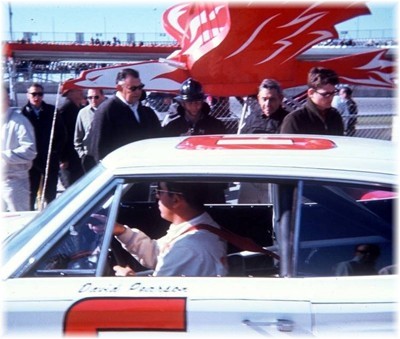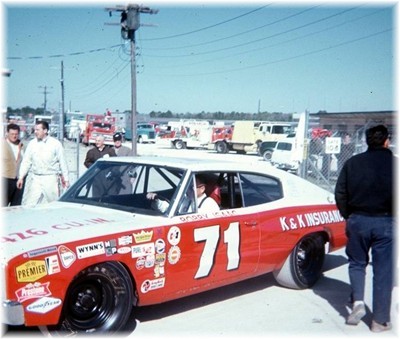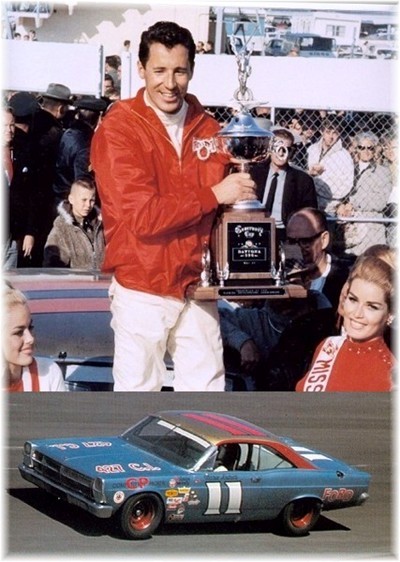1967 Daytona 500 - 40 Years Later
By Charlie O
I was born in February of 1967. This race took place just after I was born. It is the first top-tier professional race to take place after I was born. I would have so loved to see it.

A.J. Foyt
Drivers of all disciplines.
It was another era.

Richard Petty
In 1966 Mario Andretti drove 14 different cars in 51 races. He won 14 races in 4 different cars. Very few drivers in their careers have raced such a wide range of cars. With drivers like Mario Andretti, A.J. Foyt, Jackie Ickx, Jim Clark and Dan Gurney, testing their skills in NASCAR and many other racing series, it truly was the golden era of multi-purpose drivers.

Mario Andretti on the banking in the #11
Andretti was 26 at the time and he still had a touch of his native
Italian accent in his voice. His English might not have been that good, but there were no
questions about his driving talent.
"If there ever has
been a natural, it's Mario," said

Cale Yarborough

Richard Petty
Mario didn't like a car with the understeering characteristics
preferred by the NASCAR drivers. He
flew in the face of accepted practice by setting up his Ford with an extremely
soft anti-roll bar. The smallest
one in the kit actually.
"None of them would
dare run a very light bar because they were afraid the car would get too loose,"
Mario says. "We put the smallest
bar they had on my car. In fact, I
think we had to get it made. We put
it on and the car hooked up like crazy.
Donnie Allison and some of the other

After qualifying 12th, Mario took the lead for the first time on
the 21st lap of the 200 scheduled and right away it became obvious to everyone
in the packed grandstands that he would be hard to beat. It wasn't what the southern crowd had
hoped to see.
Bob Moore, a
Charlotte Observer racing reporter, was convinced. If Mario Andretti didn't wreck on the
current lap, he surely would the next.
Bob's assessment was shared widely across the press box at Daytona
International Speedway on
Even in the pit of the storied Holman & Moody team that was
fielding the Ford driven Indy-car star Andretti, an interloper in the NASCAR
Series; “We thought he was a wreck waiting to happen," remembers Waddell Wilson,
a Holman & Moody team member who had built the engine powering Andretti's
No. 11 Ford. "I have been going to races for more than 50 years, and I have
never seen a driving performance like Mario put on that day 40 years
ago."
Mario's racing line used all the track, diving down to an apex and
letting the car slide, tail out, up the banking on the exit of the corners. The NASCAR drivers thought he was
crazy. Chris Economaki remembers it
well; "Mario put his left front wheel practically on the apron going into the
corner and the right rear wheel almost brushing the wall on the exit. He was powering clear across the
track, twice a lap. It was
incredible! Nobody would run with
him. They said, 'Look at him. He is going to lose it. He'll never make it for 200 laps,' but
he did it, comfortably in the end."

David Pearson
David Pearson was the only driver who was able to match Mario's
pace, but even he found it difficult to draft Mario because of Mario's unique
line. Just after the halfway point,
Pearson suffered a blown engine, leaving Mario on his
own.
Mario's teammate was NASCAR regular Fred Lorenzen, whose speed and
movie-star good looks brought a glamorous new style to the circuit. Lorenzen appeared to be the man Ford
officials and most people in the grandstands would like to see win that
day. This became apparent during
Mario's final pit stop.

Lee Roy Yarborough
Mario says, "I was leading and came into the pits first, Lorenzen
came in and pulled into his pit stall right in front of me. I sat there up in the air and my crew
didn't release my jack until he had accelerated totally clear of the pits! It was never really confirmed and I
can't point fingers, but they made sure Lorenzen went out first from the last
stops."
By the time Mario
hit the ground he was seven seconds behind. He quickly caught and passed Lorenzen
for the lead on lap 168. Passing
him was one thing but getting away was another. "Lorenzen was the master of the draft,"
Mario says, "He latched onto me and it took a little while to figure out a way
to break away from him." With
twelve laps to go, Mario and Lorenzen came upon Tiny Lund's car.
When a caution flag came out with 2 laps left, Mario held a half lap lead. "Oh, that caution helped out," conceded Andretti, “I was just about out of gas. I pedaled around the final five miles. The way the race unfolded, having to catch and pass Lorenzen, really helps to put a premium on my performance."

"Mario is too gracious," said Waddel Wilson. "That Daytona 500 was
his as long as he could keep from going completely sideways in the turns, which
didn't seem possible and still amazes me to this day." Then he spoke with the deepest
sincerity, "It's 40 years later, half my lifetime, and I have won several
Daytona 500s. None was more enjoyable than that one in '67 with Mario Andretti.
I will remember it forever. He's as
good a person as I have ever worked with in my life, bar
none."
In my opinion, the
1967 Daytona 500 was among the best races of Mario Andretti's career. He was
phenomenal. Once the 1967 Daytona race sorted itself out, there was no question
about who the fastest driver was that day. I saw article in a recent issue of
Racer magazine by David Phillips in which Mario Andretti recalled winning at
Daytona in February 1967. Mario
told Phillips he had Richard Petty, Fred Lorenzen and the other

Mario Andretti
Sources:
Mario Andretti A Driving Passion, By Gordon Kirby
http://www.bjwor.com/020113.html
http://www.thatsracin.com/mld/thatsracin/16419451.htm
http://www.autoracing1.com/markc/000803MarioTribute.htm
http://rides.webshots.com/album/555246466XlOCiN
Wikipedia
